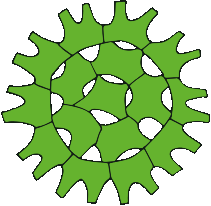Tastes good, that name. Chrysosporum - a golden seed. Does not take one's thoughts directly to the for so many odious world of the cyanobacteria, but that is the right address anyway.The young Czech cyano-researcher, Eliska Zapomelova (sorry about the missing characters in your name - I not a master enough over my keyboard to be able to produce them by myself and a simple copy-paste did not work this time) with her colleagues writes in an interesting article in Hydrobiologia about the new genus Chrysosporum, which is - as we can read - based on the further research on our old friend Anabaena b...
Read More
Author: Satu Zwerver
The catch of the day
Took a ride to Lövö today. Went to the water near the old ferry point and took a sample. Back at the office I saw some fine, common spring algae of the Baltic Sea, like this Nitzschia frigida : Nice to see some fresh algae again, after all those lugol samples.
Read More
Baltic Sea phytoplankton taxa
Wuuh, what did I find now!!? The famous Guy Hällfors Baltic Sea Phytoplankton Checklist in Excel form! Now it's possible to do all kinds of things with this data. There is a link at the Baltic Sea Portal to this page. When using Opera, you'll get this message: "Unable to complete secure transaction". But, they did kindly advice you to use IE 8 or Mozilla, didn't you read that! Ok. Mozilla then. But still, before you get to see this treasure, you have accept the page. Because when you click the link, you get the message "Security certificate is expired". It should be safe, though... I contact...
Read More
Bingo!
Just started to take a look at the Baltic Sea phytoplankton for real. And in the first field of view I see this funny thing, that you would not see in the fresh water samples: Well, this is perhaps a more estetically justified photo of the same thing: Now you see only the skeleton.This is Ebria tripartita (J.H.K. Schumann, 1867) E.J. Lemmermann, 1899, 25x30 µm.Ok, I admit. It's not phytoplankton. It's a heterotrophic flagellate, a member of "an enigmatic group of eukaryotes with an unclear phylogenetic position" as Hoppenrath & Leander (2006) so elegantly put it. But it i...
Read More
The Baltic Dinoflagellates
Spent Friday in the capitol, Helsinki. Visited Dr. Anke Kremp, a senior researcher at the Marine Research Centre/Modelling and Innovations Unit of the at the Finnish Environment Institute (SYKE) and listened with joy to all the things she had to tell about the Dinoflagellates in the Baltic Sea: the species recorded there, identification, taxonomy and the recent changes in taxonomy.Because of the brackish water in the Baltic Sea and the gradual changes of salinity along the Finnish coast the species assemblage has its very own character. A checklist of the Baltic phytoplankton was published in...
Read More
Biodiversity Heritage Library
What a wonderful place to be, this BHL! Here they have quite nice quality of pictures too. Just take a look at the original drawing of Microcystis parasitica. Not bad.You can search in many different ways: General / Books/Journals / Authors / Subjects / Scientific Names / Citation Finder (BETA) or browse by Titles | Authors | Subjects | Map | Year | Collections. Searched for Microcystis parasitica and got 21 publications! With a direct link to the PAGE where this species was mentioned. Unbelievable! And it's fast. Or maybe it's just that the rest of the village is not hanging on the net right ...
Read More
BioTar
A new interesting project has started in Finland: BioTar - Development of biological monitoring methods for the effects of the use of peat lands. The abbreviation BioTar comes from the words Biological, of course and Tarkkailu (=monitoring). The ending "-tar" means a female person in Finnish, so altogether the name gives an impression - at least to this Finnish mind - of a green, fairylike spirit leading the study. The aim of the study, that takes place between 2011 and 2014, is to find new, innovative and cost effective methods to estimate the the ecological state of the water near peat lands...
Read More
Euglenaria
Well, this is getting difficult! What we till now on were happy and content to call Euglena actually includes two groups of organisms, that have to be placed in two different genera: Euglena and the new Euglenaria. Euglenaria means Euglena-like.And they certainly are, Euglena-like. For Euglenaria's are morphologically indistinguishable from the "old" Euglena's. The difference of these taxa lies in the genes, far beyond the resolving power of the microscope. The difficulty for a regular plankton counter is, that if one can't identify a taxon to a specific Euglena-species, one has to jump one st...
Read More
Remote sensing
Kari Kallio defended earlier today his thesis on remote sensing in boreal lakes at the university of Helsinki. I wasn't there, but I took a glimpse at his thesis. Very interesting developments in technical apparatus, indeed. In a country like Finland with thousands of lakes it sure would be handy to be able to get results of many, many lakes without much effort. But. We are not there yet. A lot of algorithms still need to be calibrated. And algae counted. :)LiteratureKallio, Kari 2012. Water quality estimation by optical remote sensingin boreal lakes. Monographs of the Boreal Environment Resea...
Read More
Mytilopsis leucophaeata in the Finnish Archipelago
So, now it's confirmed. Conrad’s false mussel has been seen in the South-West Archipel area. Earlier this for Finland alien species was observed in the eastern part of the Gulf of Finland, near Loviisa, like they tell us on the Baltic Sea Portal http://www.itameriportaali.fi/en/tietoa/tulokaslajit/en_GB/mytilopsis_leu/.And today, they told in YLE news that this Mytilopsis leucophaeta has reached - or otherwise come to - Airisto. It took an American reseacher, Amy Fowler, to find them. At the university of Turku they verified the species using DNA-techniques. This little mussel looks so much li...
Read More
